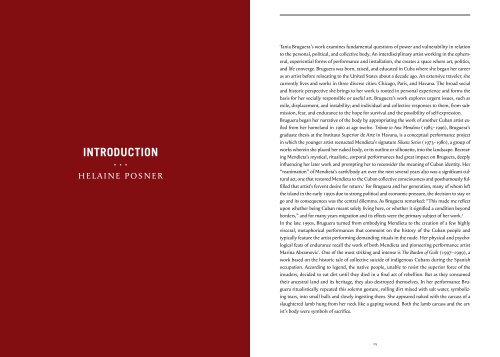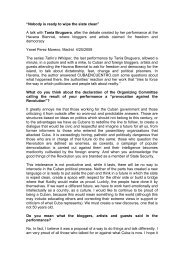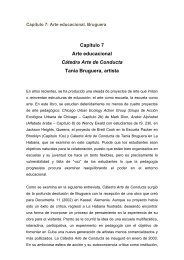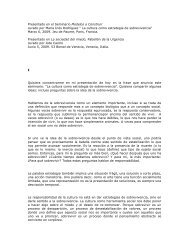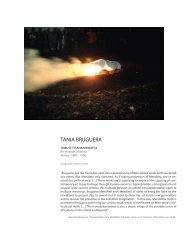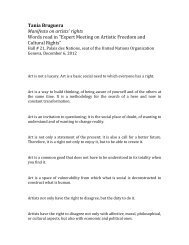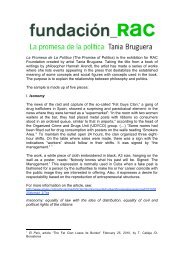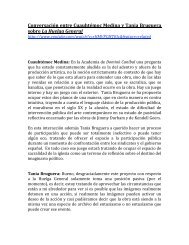Download PDF - Tania Bruguera
Download PDF - Tania Bruguera
Download PDF - Tania Bruguera
You also want an ePaper? Increase the reach of your titles
YUMPU automatically turns print PDFs into web optimized ePapers that Google loves.
INTRODUCTION<br />
· · ·<br />
helaine posner<br />
<strong>Tania</strong> <strong>Bruguera</strong>’s work examines fundamental questions of power and vulnerability in relation<br />
to the personal, political, and collective body. An interdisciplinary artist working in the ephemeral,<br />
experiential forms of performance and installation, she creates a space where art, politics,<br />
and life converge. <strong>Bruguera</strong> was born, raised, and educated in Cuba where she began her career<br />
as an artist before relocating to the United States about a decade ago. An extensive traveler, she<br />
currently lives and works in three diverse cities: Chicago, Paris, and Havana. The broad social<br />
and historic perspective she brings to her work is rooted in personal experience and forms the<br />
basis for her socially responsible or useful art. <strong>Bruguera</strong>’s work explores urgent issues, such as<br />
exile, displacement, and instability; and individual and collective responses to them, from submission,<br />
fear, and endurance to the hope for survival and the possibility of self-expression.<br />
<strong>Bruguera</strong> began her narrative of the body by appropriating the work of another Cuban artist exiled<br />
from her homeland in 1960 at age twelve. Tribute to Ana Mendieta (1985–1996), <strong>Bruguera</strong>’s<br />
graduate thesis at the Instituto Superior de Arte in Havana, is a conceptual performance project<br />
in which the younger artist reenacted Mendieta’s signature Silueta Series (1973–1980), a group of<br />
works wherein she placed her naked body, or its outline or silhouette, into the landscape. Recreating<br />
Mendieta’s mystical, ritualistic, corporal performances had great impact on <strong>Bruguera</strong>, deeply<br />
influencing her later work and prompting her to reconsider the meaning of Cuban identity. Her<br />
“reanimation” of Mendieta’s earth/body art over the next several years also was a significant cultural<br />
act, one that restored Mendieta to the Cuban collective consciousness and posthumously fulfilled<br />
that artist’s fervent desire for return. 1 For <strong>Bruguera</strong> and her generation, many of whom left<br />
the island in the early 1990s due to strong political and economic pressure, the decision to stay or<br />
go and its consequences was the central dilemma. As <strong>Bruguera</strong> remarked: “This made me reflect<br />
upon whether being Cuban meant solely living here, or whether it signified a condition beyond<br />
borders,” and for many years migration and its effects were the primary subject of her work. 2<br />
In the late 1990s, <strong>Bruguera</strong> turned from embodying Mendieta to the creation of a few highly<br />
visceral, metaphorical performances that comment on the history of the Cuban people and<br />
typically feature the artist performing demanding rituals in the nude. Her physical and psychological<br />
feats of endurance recall the work of both Mendieta and pioneering performance artist<br />
Marina Abramović . One of the most striking and intense is The Burden of Guilt (1997–1999), a<br />
work based on the historic tale of collective suicide of indigenous Cubans during the Spanish<br />
occupation. According to legend, the native people, unable to resist the superior force of the<br />
invaders, decided to eat dirt until they died in a final act of rebellion. But as they consumed<br />
their ancestral land and its heritage, they also destroyed themselves. In her performance <strong>Bruguera</strong><br />
ritualistically repeated this solemn gesture, rolling dirt mixed with salt water, symbolizing<br />
tears, into small balls and slowly ingesting them. She appeared naked with the carcass of a<br />
slaughtered lamb hung from her neck like a gaping wound. Both the lamb carcass and the artist’s<br />
body were symbols of sacrifice.<br />
14 15
By eating dirt, the native Cubans defied their conquerors with the only weapon at their disposal:<br />
passive resistance. However, their passivity was also a source of guilt as they silently<br />
succumbed to the will of the oppressor. To this day the popular Spanish expression comer<br />
tierra, or to eat dirt, means to experience very difficult times. While representing an historic<br />
event, The Burden of Guilt also has resonance in contemporary Cuba where acts of rebellion<br />
remain dangerous and submission or obedience, though shameful, may also be the surest<br />
means of survival. In this performance, <strong>Bruguera</strong> used her body to create an iconic image, one<br />
that captures the ongoing social and political reality of the Cuban experience in which the<br />
utopian promise is constantly undermined by the bitter facts of daily life. In a related work,<br />
The Body of Silence (1997–1998), the naked artist huddled in the corner of box lined with raw<br />
lamb meat making corrections in an official Cuban history textbook. Seized by a fear of the<br />
consequences, she began licking off her scribbling in an abortive attempt at self-censorship,<br />
ultimately tearing up and consuming the pages of the rewritten national narrative.<br />
<strong>Bruguera</strong> has eloquently spoken of her choice of performance as a medium. She says:<br />
I was looking for a less passive way to engage with the audience, a way in which<br />
they would also feel involved . . . I was very attracted to the idea of art as something<br />
ephemeral; as an experience, as something one lived through . . . as an<br />
agent for social change . . . Not only did performance provide a more intense<br />
experience for me in the creation of the work, but I think it was also a way of<br />
sharing with the audience with greater access and participation on their part . . .<br />
When I began to perform, I thought I found the medium with the solution to all<br />
my restlessness. It struck me as an ideal medium, ephemeral but with great impact<br />
. . . In the end, the work is remembered as images in our memory, impressions,<br />
and also as stories. The work functions as commentary. As such, I think<br />
performance can work like any other medium. 3<br />
In 2000, <strong>Bruguera</strong> was invited to participate in the 7th Havana Biennial where she created the<br />
first of four related performances/installations to be presented internationally over the following<br />
ten years. In an ambitious departure from her earlier performance work, the artist constructed<br />
a conceptually powerful, physically enveloping environment that engaged the audience<br />
as it alerted their senses of sight, sound, smell, and touch. The artist, however, was no longer<br />
present, as the focus of her work shifted from the personal to the social or political body.<br />
Untitled (Havana, 2000) took place in a darkened tunnel at La Fortaleza de la Cabaña, a former<br />
military fortress, where generations of Cubans had been imprisoned. An uneasy mood prevailed<br />
as viewers traipsed through the dark and stumbled upon layers of rotting bagazo, or sugarcane<br />
husks, covering the prison floor and emitting the noxious stench of fermentation. As<br />
Ana Mendieta, Untitled (Silueta Series, Iowa), 1977<br />
Lifetime color photograph<br />
13 1/4 x 20 inches<br />
Des Moines Art Center<br />
© The Estate of Ana Mendieta Collection<br />
Courtesy Galerie Lelong, New York<br />
visitors anxiously made their way through the dark and over the thick, fetid detritus, they<br />
spotted a blue light in the distance. It was a video monitor displaying silent archival footage<br />
of Fidel Castro in his prime, giving a well-known speech, swimming in the ocean, and waving<br />
to the crowd, punctuated at one-minute intervals by the image of the leader bearing his<br />
chest. Unexpectedly, the shadowy figures of four naked men emerged from the darkness,<br />
each performing a single, repetitive gesture. One rubbed his body as if to remove the smell<br />
of the sugarcane, another used his fingers to pry open his mouth, a third wiped his face with<br />
his forearm, and the last slowly bowed. On exiting the tunnel the visitor was blinded by the<br />
bright Caribbean sun.<br />
In this work, <strong>Bruguera</strong> offered a subtle, yet penetrating critique of Cuban life since the socalled<br />
triumph of the revolution. In hindsight, she suggests, the glorious past is revealed to<br />
have been nothing more than a series of “repeated rituals and empty gestures,” and the people<br />
so seduced by power that they have become blind to what is happening all around them. 4<br />
Essentially, Untitled (Havana, 2000) was a call for greater political awareness and responsibil-<br />
16 17
Juan Francisco Elso, Por América (For America [José Marti]), 1986<br />
Wood, plaster, earth, pigment, synthetic hair, and glass eyes<br />
56 3/4 x 17 1/4 x 18 1/4 inches (entire work: dimensions variable)<br />
Hirshhorn Museum and Sculpture Garden, Smithsonian Institution,<br />
Joseph H. Hirshhorn Purchase Fund, 1998<br />
Photograph by Lee Stalsworth<br />
ity on the part of the Cuban people presented in the context of an international art event. The<br />
impact of this message was such that the installation was officially closed after one day.<br />
Two years later, <strong>Bruguera</strong> had the opportunity to test whether her work, which so far had been<br />
based in her Cuban experience, would translate to a major international setting when she was<br />
asked to create an installation for Documenta 11 in Kassel, Germany. Untitled (Kassel, 2002) returned<br />
to the theme of social responsibility within a vastly different yet equally charged geopolitical<br />
site. Once again, the artist used light and darkness to examine such concerns as power<br />
and vulnerability, and historic memory versus cultural amnesia; or the question of what we as<br />
a society choose to acknowledge and act upon and what we choose to ignore.<br />
All elements of Untitled (Kassel, 2002) conspired to create a sense of vulnerability in the viewer,<br />
prompting memories of wartime and, given the location, World War II. A row of 750-watt<br />
lights was strung on a trestle above the entrance to the installation, assaulting the eyes of the<br />
viewer as if under interrogation. The metallic clicking sound of a person on patrol loading<br />
and unloading a gun was heard overhead. At first one did not know whether this sound was<br />
live or recorded, but it gradually became clear that real human beings were watching and, in<br />
theory, threatening one’s life. Suddenly the bright lights went out, the sound ceased and, for<br />
a few moments, the darkened space was dimly lit by a projection displaying the names of one<br />
hundred locations across the globe where political massacres have occurred since the end of<br />
World War II, some resulting in enormous casualties. With the city of Kassel, once the site of<br />
a large ammunition factory and a target of severe bombing during the war, as context, <strong>Bruguera</strong><br />
encouraged the audience to recognize the global reach of political violence as personal<br />
threat by placing them directly in the line of fire.<br />
<strong>Bruguera</strong> continued to tackle hot topics in her work but in a more conceptually and formally<br />
cool manner. In conversation, she described this shift in approach as “more Felix Gonzales-Torres<br />
than Ana Mendieta,” citing another Cuban-born artist whose work combined<br />
the impulses of conceptual and minimal art with social themes to create formally restrained<br />
yet emotionally poignant installations. Essentially, her work became less visceral and more<br />
theoretical. The untitled series also marked another important change in her practice as she<br />
moved from presenting herself as performer to engaging the audience as active participants.<br />
The third in the artist’s series of performances/installations, called Untitled (Moscow, 2007) or<br />
Trust Workshop, was a year-long project presented as part of the 2 nd Moscow Biennale of Contemporary<br />
Art. In this work, <strong>Bruguera</strong> set up a situation in which she invited Russian citizens<br />
to share their lingering distrust of Soviet officials with the workshop coordinator, a former<br />
KGB agent. They told personal stories of misfortune or political persecution to the agent,<br />
who used specialized skills developed in Cold War training to redress the painful psychological<br />
repercussions of the era and to begin to restore trust. The primary goal of the workshop<br />
was to heal the generational and ideological gaps that separate the Russian people as their<br />
country enters a new social, political, and economic era.<br />
<strong>Bruguera</strong>’s performance/installation took the form of a photography studio in which visitors<br />
were invited to pose for their portraits beneath a framed photograph of Felix Dzerzhinsky,<br />
founder of the Bolshevik secret police. The anxious participants and their families were asked<br />
to choose between having their picture taken with a live eagle or with a monkey. According<br />
to the artist, the eagle, poised on the subject’s shoulder, was intended to signify history,<br />
power, and the establishment, while the monkey, dressed in children’s clothing and propped<br />
on one’s lap, represented youth, pleasure, and the rise of capitalism in the new Russia. The<br />
choice was clearly symbolic: either one could hold on to the old ideology or cast off the vestiges<br />
of a repressive regime and move forward.<br />
In the untitled series the artist made a significant transition from exploring power relations<br />
within her own country to reflecting more broadly on the ways in which different social or<br />
political entities relate to their histories and issues of moral conscience and express their<br />
hopes and fears. The series is completed by Untitled (Bogotá, 2009) and Untitled (Palestine,<br />
18 19
2009), currently in-progress, which will be presented at the 3 rd Riwaq Biennale and will examine<br />
some of the complexities of that contested site.<br />
Teaching is an important part of <strong>Bruguera</strong>’s professional life and is closely tied to her artistic practice.<br />
She is an Assistant Professor in the Department of Fine Arts at the University of Chicago and,<br />
until recently, she ran an art school called the Cátedra Arte de Conducta under the auspices of<br />
the Instituto Superior de Arte in Havana, which also functioned as a conceptual work of art. The<br />
goal of this school was to teach a younger generation of Cubans to develop ways to make art that<br />
can play an active role in society, using human behavior as an artistic material. <strong>Bruguera</strong> describes<br />
Arte de Conducta, or behavior art, as a counterpoint to performance art. Rather than use the body<br />
to create signature images as in performance, in Arte de Conducta one constructs situations that<br />
compel the audience to examine their behavior and to respond, not simply observe. In <strong>Bruguera</strong>’s<br />
recent Arte de Conducta actions, she employed various strategies of power, from propaganda and<br />
crowd control to more subtle forms such as an academic lecture and the granting of free speech,<br />
to create a series of lived experiences that prompted collective reactions.<br />
A stunning example of <strong>Bruguera</strong>’s new work took place on the bridge of Turbine Hall at Tate<br />
Modern in London where museum-goers were confronted by two uniformed policemen on<br />
horseback practicing a full range of crowd control techniques. Visitors responded to these imposing<br />
figures as they would in real life, yielding to the officers’ verbal instructions and to the<br />
animals’ commanding physical presence. The action did not appear to be an art event and the<br />
audience reacted predictably to this demonstration of power. Tatlin’s Whisper #5 (2008) succeeded<br />
in making viewers more aware of their reflexive passivity in the face of authority and<br />
encouraged them to reexamine their conditioned responses.<br />
<strong>Bruguera</strong> created the sixth in this series of actions designed, in her words, to “reproduce images<br />
familiar from the media as direct and participatory experiences” for the 10th Havana Biennial.<br />
5 In Tatlin’s Whisper #6 (Havana Version) (2009), she constructed a raised podium in the<br />
central courtyard of the Wifredo Lam Center, distributed 200 disposable cameras, and invited<br />
audience members to step up to the microphone and exercise freedom of speech for one minute<br />
each. This call tapped into deep emotions in a country that has repressed free speech for<br />
nearly fifty years and where the consequences of self-expression can be grave. During the performance,<br />
each speaker was flanked by two individuals dressed in military fatigues who placed<br />
a white dove on his or her shoulder, evoking the moment in 1959 when a dove alighted on Fidel<br />
Castro during a famous speech.<br />
A variety of anti- and some pro-revolutionary voices were heard, a woman wept, and a young<br />
man said he never felt so free. Nearly forty people spoke in all. Their calls for freedom echoed<br />
for an hour, after which time the artist ended the performance by stepping up to the podium<br />
and thanking the Cuban people. By providing a public platform for the audience to speak out<br />
against censorship, to call for liberty and democracy, or to state whatever was on their mind,<br />
the artist tested the limits of acceptable behavior under a totalitarian regime in an attempt to<br />
create a socially useful forum. In the following days, the event was officially renounced by the<br />
Biennial’s organizing committee, but by then the people had spoken and footage of their statements<br />
received over 47,000 hits on YouTube.<br />
In 2006, <strong>Bruguera</strong> signed a notarized agreement with artist J. Castro called L’accord de Marseille<br />
stating that when one of them dies, the other will present a performance using his or her dead<br />
body. The work may take several forms including a collaboration, a legal agreement, a public<br />
question and answer session, an object to be displayed in a museum, and the performance itself.<br />
It also poses a number of important questions, first and foremost: “What is art?” Like much of<br />
<strong>Bruguera</strong>’s work, the accord blurs the boundaries between art and life, here in an extreme way.<br />
L’accord de Marseille also tests another limit: that of the personal body as repository of art and<br />
site of social critique, converting the artist’s body into a legal body within the public sphere.<br />
<strong>Tania</strong> <strong>Bruguera</strong>’s art traces a remarkable course that begins with her body and personal experience,<br />
goes on to explore the greater political and communal body, and encourages us to consider<br />
individual responsibility within a global context. Her journey has taken her from the Cubanthemed<br />
body performances of the 1990s, through a series of major performances/installations<br />
that look at the social and political implications of such charged international sites as Havana,<br />
Kassel, Moscow, and Palestine to a new form called Arte de Conducta or behavior art, in which<br />
she stages live events meant to activate and engage viewer response. Throughout her work, she<br />
has used her Cuban experience of cultural displacement and marginality as a prism through<br />
which to examine the mainstream and the individuals’ often difficult relationship to power. She<br />
credits her teacher, the acclaimed Cuban artist Juan Francisco Elso Padilla (1956–1988), with<br />
providing inspiration for her work, stating:<br />
I took from him the idea that art had to be completely linked with life—and<br />
not a fiction or a virtual reality, but as alive as possible. My art has to have a<br />
real function for myself, to heal my problems or to help other people to reflect<br />
and improve . . . 6<br />
For <strong>Bruguera</strong>, art serves as testimony, as social commitment, and as emotional experience, and<br />
is, foremost, ethical at its core.<br />
1. Gerardo Mosquera, “Reanimating Ana Mendieta,” Poliéster, 4, Winter 1995, p. 52. I am grateful<br />
to Gerardo Mosquera for his insight into the impact of <strong>Bruguera</strong>’s reenactment of Mendieta’s Silueta Series in Cuba.<br />
2. Euridice Arratia, “Cityscape Havana,” Flash Art 32, January/February 1999, p. 48.<br />
3. “<strong>Tania</strong> <strong>Bruguera</strong> in Conversation with Octavio Zaya,” in Cuba: Maps of Desire. Vienna: Kunsthalle Wien, 1999, pp. 245, 249.<br />
4. Nico Israel, “VII Bienal de la Habana,” Artforum 39, February 2001, p. 148.<br />
5. In conversation with the artist on September 15, 2009.<br />
6. Johannes Birringer, “Art in America (The Dream): A Conversation with <strong>Tania</strong> <strong>Bruguera</strong>,” Performance Research 3,<br />
Spring 1998, p. 26.<br />
20 21


